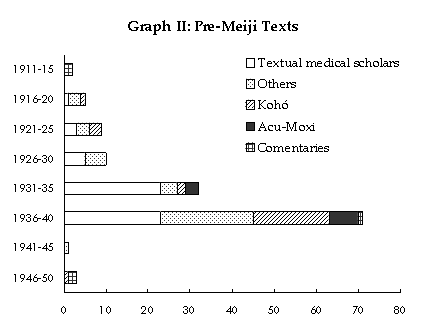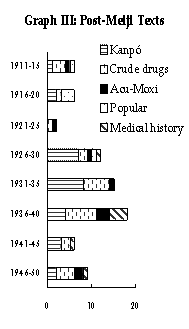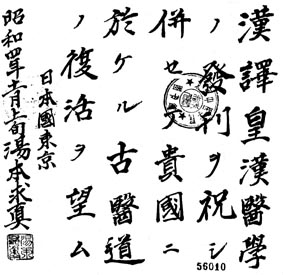




| Date | Series name�i# of indiv. texts�j | Genre of Japanese medicine�F# of books |
| 1913 | �Z桊��Λ{�p��Liuyiguan Yiyao Congshu (22) | Commentary on Textual medical scholars: 2 |
| 1915 | ��p��Yiyao Congshu (56) | �iNatural medicine: 1�j |
| 1923 | �O�O�Ώ�Sansan Yishu (99) | Textual medical scholars: 2�@Others: 1�@Kohó: 5 |
| 1928 | ����Λ{�p��Yaoan Yixue Congshu (22) | Commentary on Textual medical scholars: 1 |
| 1929 | ���{���Ώ�����������Riben Hanyi Shanghan Mingzhu Heke (2) | Textual medical scholars: 2 |
| 1931 | ���Ώ��p��Guoyi Xiaocongshu (34) | Others: 2�@Kohó: 1 |
| 1931 | �����Λ{�p��Heshi Yixue Congshu (4) | Textual medical scholars: 2 �@Commentary on Textual medical scholars: 1 |
| 1936 | �c���Λ{�p��Huanghan Yixue Congshu (72) | Text-med.: 16�@ Others: 26�@ Kohó: 16�@Acu-moxi: 3 |
| 1936 | ���{�Ώ��W��Zhenben Yishu Jicheng (90) | �iKampó: 2 Nat. Medicine: 5 Acu-moxi: 1�@History: 3�j |
| 1936 | �����Λ{�听 Zhongguo Yixue Dacheng (134) | Others: 1�@ |
| 1937 | �Ö{�Λ{�p�� Guben Yixue Conggan (2) | Text-med.: 1 Commentary on Text. medical scholars: 1�@Others: 1�@ Kohó: 2�@History: 1 Acu-moxi: 1 |
 Among the
texts with the highest number of publications, the most well-published
post-Meiji work was Yumoto Kyushin���{�����fs Kókan
Igaku�c���Λ{, with 2 translated versions and 7 publications (if we include the
People�fs Republic period as well, 9 publications). Yumoto�fs Rinshó
Óyó Kanpo Igaku��ଜ�p�����Λ{ had 3 different translated versions, reflecting
the popularity that Yumoto�fs work enjoyed during this
period. For example, Yumoto wrote a
congratulatory address (Map I) to
Zhou Zixu���q���fs translation of the Kókan Igaku text, and Zhou wrote in the
preface of this book, �gEveryone, the things Yumoto says are the things I want
to, but cannot. In the face of the
extinction of traditional medicine, surely this text will be a lifesaver.
Yumoto�fs scientific experiments are not unfounded abstractions. They make clear
the wonderful effects of our ancient prescriptions, which cannot simply be put
mechanically into practice. Yumoto�fs scientific experiments are the standards
of the medical world, and the basis for the revival of our people.�h[23]
Among the
texts with the highest number of publications, the most well-published
post-Meiji work was Yumoto Kyushin���{�����fs Kókan
Igaku�c���Λ{, with 2 translated versions and 7 publications (if we include the
People�fs Republic period as well, 9 publications). Yumoto�fs Rinshó
Óyó Kanpo Igaku��ଜ�p�����Λ{ had 3 different translated versions, reflecting
the popularity that Yumoto�fs work enjoyed during this
period. For example, Yumoto wrote a
congratulatory address (Map I) to
Zhou Zixu���q���fs translation of the Kókan Igaku text, and Zhou wrote in the
preface of this book, �gEveryone, the things Yumoto says are the things I want
to, but cannot. In the face of the
extinction of traditional medicine, surely this text will be a lifesaver.
Yumoto�fs scientific experiments are not unfounded abstractions. They make clear
the wonderful effects of our ancient prescriptions, which cannot simply be put
mechanically into practice. Yumoto�fs scientific experiments are the standards
of the medical world, and the basis for the revival of our people.�h[23]